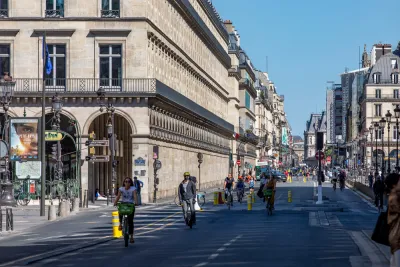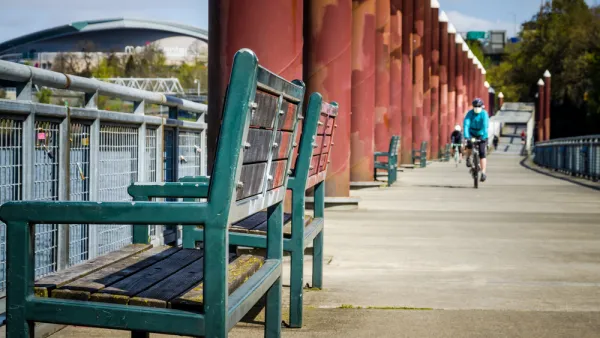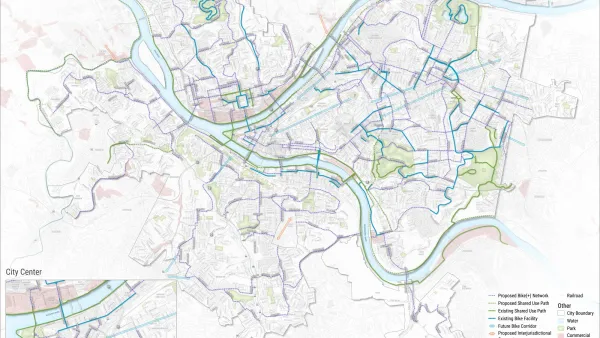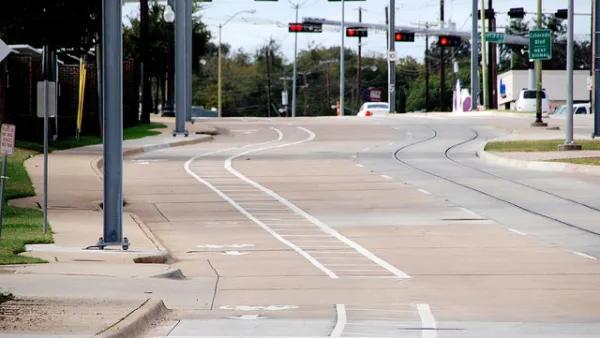New research ties pop up bike lanes implemented in Europe during the pandemic to increased levels of biking.

Veronica Penney shares the news: "Adding bike lanes to urban streets can increase the number of cyclists across an entire city, not just on the streets with new bike lanes, according to a new study."
"The finding adds to a growing body of research indicating that investments in cycling infrastructure can encourage more people to commute by bike," adds Penney.
The study, authored by Sebastian Kraus and Nicolas Koch and published in April by the Proceedings of the National Academy of Sciences of the United States of America, quantifies its findings thusly: "in cities where bike infrastructure was added, cycling had increased up to 48 percent more than in cities that did not add bike lanes."
The effect varies depending on the density of development and public transit. Denser, transit-oriented cities saw larger increases. "Paris, which implemented its bike lane program early and had the largest pop-up bike lane program of any of the cities in the study, had one of the largest increases in riders," according to Penney's explanation fo the study.
The article includes more details on the study's findings, as well as an explanation of the study's methodology. Penney also connects the study' findings to bike mobility as a tool in the effort to reduce greenhouse gas emissions.
While the study focused on Europe, it's worth noting that the city of Bogotá, Colombia, also the originator of Ciclovía, was the first to temporarily expand bike infrastructure in the name of public health during the pandemic, opening 76 km (47 miles) of temporary bike lanes to reduce crowding on public transport in early March. The actions of Bogotá to increase bike infrastructure were one of the clearest, early signs of the many ways the public health responses of the pandemic would interest with issues of planning.
FULL STORY: If You Build It, They Will Bike: Pop-Up Lanes Increased Cycling During Pandemic

Analysis: Cybertruck Fatality Rate Far Exceeds That of Ford Pinto
The Tesla Cybertruck was recalled seven times last year.

National Parks Layoffs Will Cause Communities to Lose Billions
Thousands of essential park workers were laid off this week, just before the busy spring break season.

Retro-silient?: America’s First “Eco-burb,” The Woodlands Turns 50
A master-planned community north of Houston offers lessons on green infrastructure and resilient design, but falls short of its founder’s lofty affordability and walkability goals.

Test News Post 1
This is a summary

Analysis: Cybertruck Fatality Rate Far Exceeds That of Ford Pinto
The Tesla Cybertruck was recalled seven times last year.

Test News Headline 46
Test for the image on the front page.
Urban Design for Planners 1: Software Tools
This six-course series explores essential urban design concepts using open source software and equips planners with the tools they need to participate fully in the urban design process.
Planning for Universal Design
Learn the tools for implementing Universal Design in planning regulations.
EMC Planning Group, Inc.
Planetizen
Planetizen
Mpact (formerly Rail~Volution)
Great Falls Development Authority, Inc.
HUDs Office of Policy Development and Research
NYU Wagner Graduate School of Public Service




























